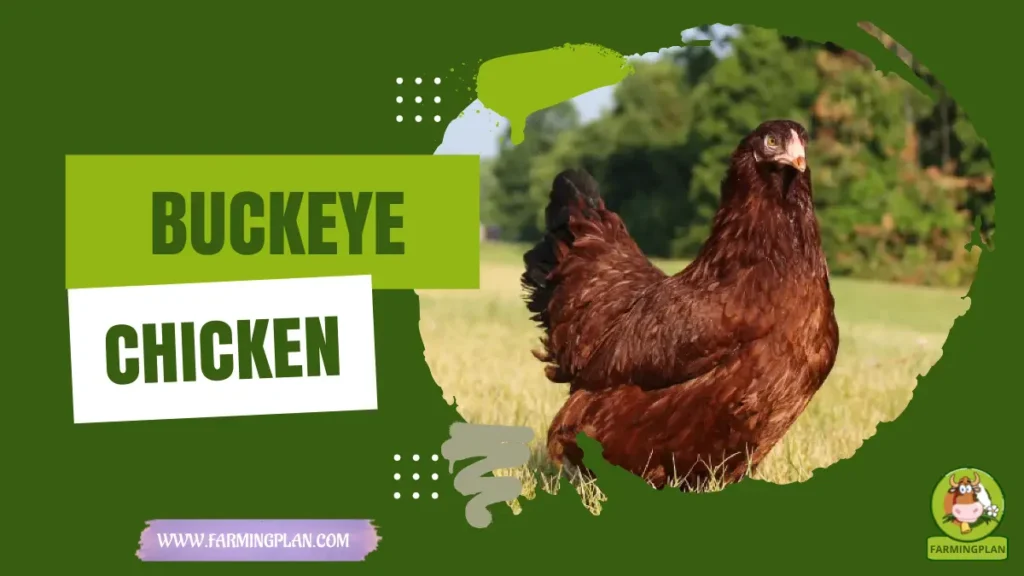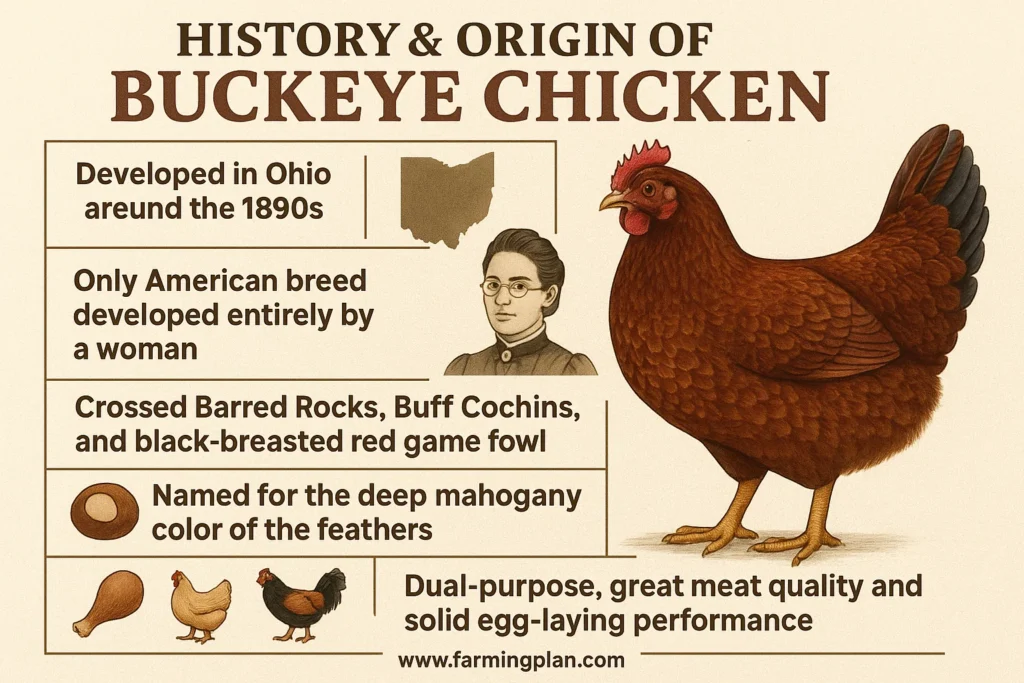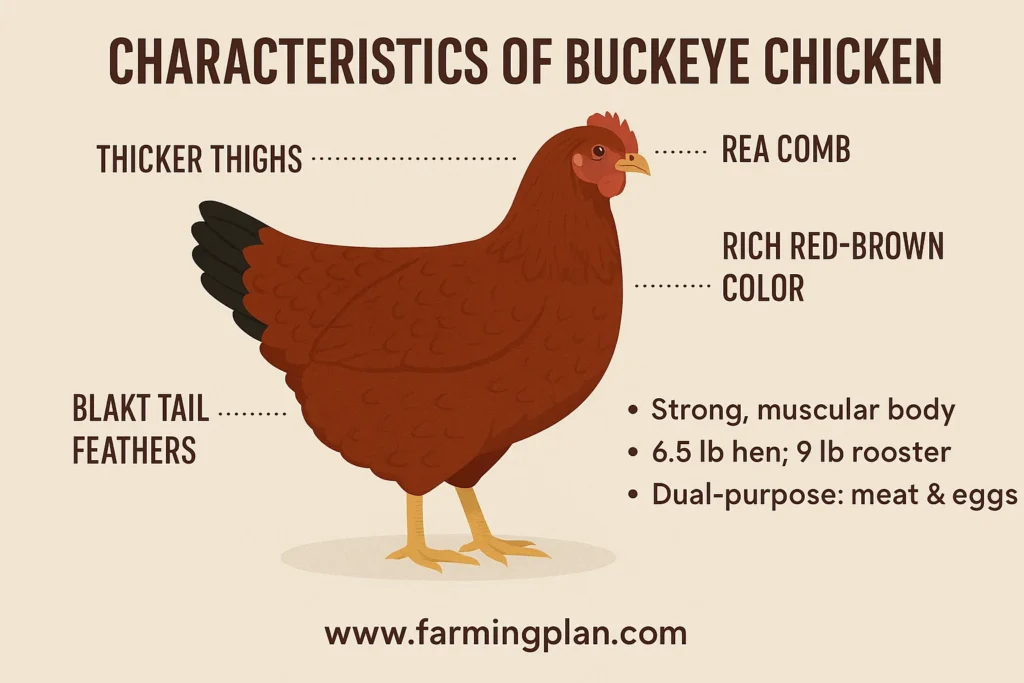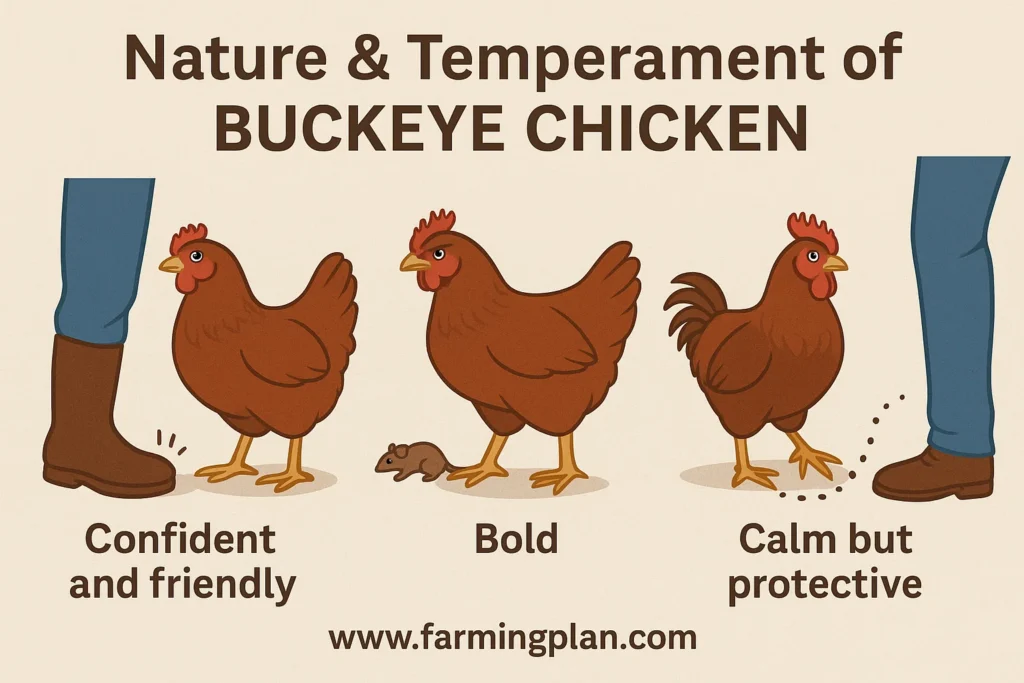If you’re after a chicken with personality, productivity, and toughness, the Buckeye Chicken is a top pick. These deep-red birds aren’t just pretty—they’re hardy, dual-purpose champs that lay well and offer excellent meat. With tight feathering, muscular builds, and a pea comb that resists frostbite, Buckeyes are ideal for cold climates and backyard flocks alike. I’ve raised them for years and love their friendly nature, foraging ability, and even their knack for catching mice! Whether you’re a beginner or seasoned farmer, Buckeyes fit right in. In this guide, I’ll cover everything from their history and care to egg-laying tips and where to find chicks. Let’s dive into the world of Buckeye chickens!

History & Origin of Buckeye Chicken
The Buckeye Chicken isn’t just any old barnyard bird—it’s a piece of poultry history. Developed in Ohio around the 1890s, this breed was the brainchild of a determined woman named Nettie Metcalf, who wanted a chicken that could stand up to Ohio’s cold winters. She crossed Barred Rocks, Buff Cochins, and black-breasted red game fowl to create a tough, meaty, and productive chicken.

What’s especially unique is that Buckeyes are the only American breed developed entirely by a woman—pretty cool, right? They got their name from the deep mahogany color of their feathers, which resembles the buckeye nut native to Ohio. Ever since, they’ve been treasured by poultry lovers for their dual-purpose abilities, great meat quality, and solid egg-laying performance. They’re now listed as a heritage breed and are seeing a happy resurgence among backyard flocks.
Read More: Java Chicken: Farming What You Need to Know
Characteristics of Buckeye Chicken
When I first got my hands on a Buckeye pullet, I was surprised by how sturdy and muscular she felt. These birds have thicker thighs, broad breasts, and strong, meaty bodies—making them excellent meat producers. One standout feature? That pea comb. Unlike the single combs most breeds have, the Buckeye’s close-fitting pea comb helps prevent frostbite, which is a blessing during cold winters.

Buckeyes sport tight feathering and a rich red-brown color with black tail feathers. Males often have a bit more shine, especially in the saddle and hackle areas. Their wings are powerful, and though they aren’t great fliers, they’re agile and quick. On average, a Buckeye hen weighs about 6.5 pounds, and roosters can hit 9 pounds. That makes them perfect for both meat and egg production—classic dual-purpose birds.
Read More: Penedesenca Chicken: Raise Happy, Hardy Birds
Nature & Temperament of Buckeye Chicken
These birds have personality, no doubt. While some chickens are shy or flighty, Buckeye chickens are confident and friendly. They don’t have a strong fear of humans, so they’ll happily peck around your boots while you do your chores. I’ve even seen them follow me like puppies, curious about everything I’m doing.

That said, don’t underestimate them. They’re bold, and their pursuit of mice is legendary. Yes—you heard that right. Buckeyes have a bit of a predator side and are known to hunt mice in the coop! Roosters are generally calm, but still protective without being aggressive. This balance makes them perfect for family farms, even with kids around.
Read More: Houdan Chicken: A French Breed of Livestock
Food & Diet
Buckeye chickens aren’t picky eaters, but they do thrive best on a balanced poultry diet. I feed mine a standard layer or grower feed, depending on age, and supplement it with grains, veggies, and free-range time. They love foraging, which helps keep pests in check.
For laying hens, I always ensure they get extra calcium—crushed oyster shells work great. Don’t feed them raw potatoes, avocado skins, or chocolate. Keep fresh water available at all times, and if you want better meat yield, add some protein-rich treats like mealworms. A healthy Buckeye grows into a thick-thighed, meat-rich bird that’s a joy to cook with or watch scratch around your yard.
Usage & Purpose
Buckeye chickens are the epitome of dual-purpose poultry. They reliably lay 3–4 eggs per week, and when it’s time for meat production, their excellent meat quality shines through. Their meaty thighs and full breasts make them a top choice for small-scale meat production. I’ve also shown Buckeyes at local poultry events—judges love their balanced build and classic feather color. They do well in backyard flocks, homesteads, and even smaller urban settings. Whether you’re raising them for food, fun, or show, Buckeyes fit the bill.
Buckeyes Are Like The Swiss Army Knife Of Chickens—Tough, Tasty, And Totally Trustworthy!
Special Features
What makes Buckeyes stand out from your average backyard bird? Their unique features, such as the close-fitting pea comb that’s practically immune to frostbite, and their natural pest control abilities as they actively hunt rodents. These traits, combined with their weather hardiness, make them a practical choice for farmers in northern climates like mine.
Then there’s their weather hardiness. I’ve watched Buckeyes strut through snow like it’s a summer day. Their compact bodies and tight feathers help them conserve heat. Add in their friendly nature, reliable egg production, and excellent meat—and you’ve got a chicken that can do it all.
Health Issues & Prevention
Like most chickens, Buckeyes can face common health issues such as mites, respiratory infections, and internal parasites. To prevent these, it’s crucial to keep the coop clean, dry, and well-ventilated. Regular deworming and keeping an eye out for signs of illness, such as swollen eyes or runny noses, are also important.
Deworming on a routine schedule helps keep internal bugs in check. Also, watch for swollen eyes, sneezing, or runny noses—these could signal a respiratory issue. Provide access to clean water, fresh feed, and plenty of space to move. Healthy Buckeyes are active, curious, and downright entertaining.
Step-by-Step Buckeye Chicken Care Guide
Step 1: Set Up The Perfect Coop
Make sure your coop is draft-free but well-ventilated. Buckeyes do great in colder climates, but they still need shelter. I give each chicken about 4 square feet inside and 10 square feet in the run. Use deep bedding like straw or wood shavings and clean it weekly. Their pea combs help avoid frostbite, but I still make sure there’s no dampness during winter. Provide sturdy perches, nesting boxes, and predator-proof fencing. Don’t forget a shaded spot in summer—they’re tough, but they still need a break from the heat.
Step 2: Start With Healthy Chicks Or Pullets
You can buy Buckeye chicks for sale from hatcheries or local breeders. Look for active, bright-eyed chicks with clean vents. I start mine on chick starter feed with 20–22% protein and switch to grower feed at around 8 weeks. Keep them warm with a brooder lamp, aiming for 95°F the first week and lowering the temperature by 5°F each week. By 6–8 weeks, they’re usually ready to move outside.
Step 3: Daily Feeding & Watering Routine
I fill their feeders once a day with quality layer feed and scatter some grains for entertainment. Buckeyes love to scratch and peck. Water gets changed daily, especially in summer. In winter, I use a heated waterer to keep things from freezing. They’ll gobble up kitchen scraps—greens, rice, oatmeal—but avoid giving them junk food or moldy stuff. I also toss a handful of cracked corn or sunflower seeds as treats and to boost energy.
Step 4: Keep ‘Em Active And Healthy
Let them out to free-range, if possible. Buckeyes are natural foragers and help control pests. I rotate my flock across the yard to keep the grass growing and bugs under control. Watch their behavior daily—sudden changes can signal health problems. Trim overgrown nails, and give them dust baths for parasite control. Happy Buckeyes flap their powerful wings, hunt for bugs, and chatter away with each other.
Expert Tips & Best Practices For Buckeye Success
- Always Buy From Reputable Hatcheries – Look for healthy Buckeye Day Old Chicks.
- Use Deep Bedding Method – It keeps your coop cleaner and birds warmer.
- Encourage Foraging – These birds love to roam and hunt mice.
- Inspect Weekly For Mites & Lice – Early detection saves trouble later.
- Keep a Mixed Flock Carefully – Buckeyes get along well but don’t like being bullied.
- Collect Eggs Daily – Buckeye chicken eggs are rich and delicious—don’t let them freeze or spoil.
FAQ
Are Buckeye chickens good layers?
Yes, Buckeye hens lay about 3–4 medium brown eggs per week, even in colder weather.
Do Buckeye chickens do well in cold climates?
Absolutely! Their pea comb and dense feathers make them incredibly cold-hardy.
Can Buckeye chickens live in backyard flocks?
Yes, they thrive in backyard setups and get along well with people and other chickens.
Where can I buy Buckeye chickens or chicks?
You can find Buckeye chickens for sale at hatcheries, local breeders, and poultry shows.
Are Buckeye roosters aggressive?
Generally, no. They’re protective but calm, making them a safe choice for family farms.
Conclusion
From their rich red feathers to their excellent meat and egg-laying abilities, Buckeye chickens are true barnyard champions. They’re a joy to raise—weather-hardy, friendly, active, and downright useful. Whether you’re just getting started with chickens or adding to your established flock, Buckeyes bring flavor, charm, and functionality to any setup. I’ve worked with many breeds over the years, but Buckeyes always stand out. If you’re ready to bring home a bird that can do it all, I say buy Buckeye chickens and see the difference for yourself! Got questions or stories about your Buckeye flock? Drop me a message or share your experience—let’s talk poultry!

